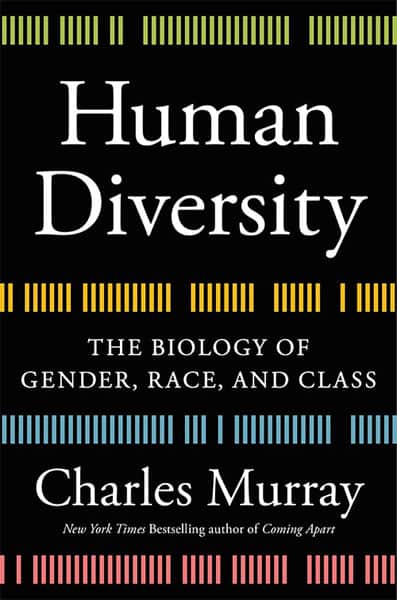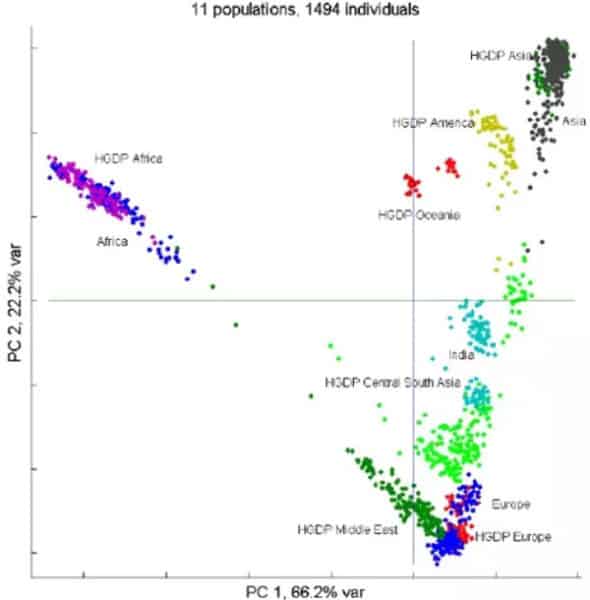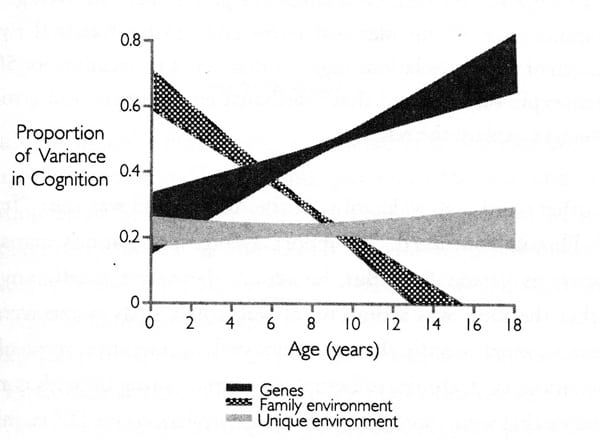Charles Murray’s ‘Human Diversity’
Jared Taylor, American Renaissance, February 7, 2020

Charles Murray, Human Diversity: The Biology of Gender, Race, and Class, Grand Central Publishing, 2020, 528 pp., $31.50.
In Human Diversity, Charles Murray sets out to demonstrate three things: (1) There are biological reasons why men and women behave differently. (2) Human populations have evolved so many genetic differences that different groups cannot be expected to think and behave identically. (3) Increasingly, the people who are rich and influential got that way because they have biologically rooted talents and abilities, not because of unfair privilege.
As he always does, Dr. Murray bases his conclusions on an exhaustive survey of the relevant literature. This is his most scientifically ambitious book — much of the material comes from genetics research that uses complex, cutting-edge analysis — but Dr. Murray has a gift for explaining science. It is hard to imagine a better introduction to, as the book’s subtitle baldly puts it, the biology of gender, race, and class.
The pity is that this book should not have had to be written. It is necessary only because universities and big media continue to assert that the sexes and races are identical from the neck up, and that the only reason some people do well in life is because they are undeserving darlings of the “white hetero-normative patriarchy.” Orthodoxy is firmly entrenched, and it will take more than a single book to dislodge it, but none is likely to strike a more powerful blow than Human Diversity.

The sexes
In what must be one of the most colossal errors in intellectual history, it is now fashionable to think that there is no such thing as a typically male or female nature. Plenty of people at least claim to believe that sex differences are artificially imposed by some nefarious group that wants women to behave one way and men another. But “why should it be,” asks Dr. Murray, “everywhere and throughout history, that certain differences between the sexes have been so consistent? Isn’t it simpler to assume that we’re looking at innate differences produced by millions of years of evolution?”
It might — just might — be possible to convince yourself that only 4 percent of US patents are granted to women because society steers them away from science. But can anyone truly believe that the only reason 88 percent of the people arrested for murder are men is because society steers them that way? Or that women almost never pay for sex but men do — only because someone said they should?
Although there is obviously a lot of overlap in most traits, average males and females are different from birth, well before the “patriarchy” gets its hands on them. Infant girls cry longer than boys in response to recordings of another baby crying. They maintain eye contact with an adult longer. They are more responsive to their mothers’ voices. They look longer at pictures that relate to people whereas infant boys look longer at pictures of balls or trucks.
This is consistent with what Dr. Murray calls the broad preference women have for people over things, and the reverse preference for men. Women are better at reading the emotional states of others. As Dr. Murray notes, “Women may be only modestly better than men at figuring out the emotions that women are feeling, but they are definitely better than men at figuring out the emotions that men are feeling.” Negative emotions are harder to tell than positive ones, and women are particularly good at that.
Men are more interested than women not only in machinery but in systems: math, physics, logic, corporate organization. Men also like sports and anything to do with weapons and war. Once, in New York City, I stopped to admire a beautifully painted and chromed 18-wheeler parked on a narrow side street. After a while, I started noticing the passersby: Every man gave the rig at least an admiring look and many stopped as I had; not one woman so much as glanced at it.
Women react more strongly to disgusting images, and appreciate art and beauty more than men do. They have higher levels of free-floating anxiety, are more vulnerable to stress, and are less able to ignore irritants. They are more open to inner feelings and emotions, and more modest about their achievements. They are more affected by their feelings and more easily upset. Women have slightly better senses of smell, taste, touch, vision, and sound. Men are far more likely to be colorblind. Men are more likely to be left handed and to have developmental problems such as stuttering, dyslexia, and autism. But men can throw things more accurately.
Females have somewhat better verbal ability than males, and males have somewhat better math and visuospatial ability. Please look at the test question below. Although you’d think anyone capable of human speech would get it right, Dr. Murray tells us that fully 40 percent of college women get it wrong. After puberty, men are more likely to get top scores in both math and language. There are five-to-eight times more men than women in the top levels of math ability.

Men read maps better than women and navigate by a kind of internal dead reckoning while women navigate by landmarks. Curiously, although the 95 winners of the annual National Spelling Bee contest are almost perfectly split between boys and girls, 27 of the 29 National Geography Bee winners have been boys.
Men and women have different patterns of memory. Women have better “autobiographical memory,” which means they remember more details about their lives. They also remember more details about an event, whereas men may have a better grasp of its gist, or its central facts. For men, memory correlates closely with IQ; less so for women. Dr. Murray reports that women with IQs of 60 to 80 have considerably better memory for human faces than men with IQs of 101 to 120.
On most measures of ability and personality, there is more variance in men, that is to say, they are more likely than women to be at the extremes. As Dr. Murray notes, “in childhood, the sex differences in variability are scattered and small. Male variability increases after puberty.” One large-scale study found twice as many men as women at both IQ extremes: over 140 and below 60.
Most Western countries have tried to end bias in how boys and girls are reared. Many would say we haven’t tried hard enough, but it would be hard to deny that Sweden, for example, tries a lot harder than Jordan or Saudi Arabia. Has the West at least narrowed sex differences? No; differences in temperament and ability are greater in the West. Dr. Murray is just as surprised by this as anyone, but thinks that perhaps when society does not trumpet sex roles, “both sexes become freer to do what comes naturally.”
What does that mean for career choice? Dr. Murray reports that for men, high ability in either verbal or mathematics/visuo-spatial ability may be a trade-off; if a man is good at one, he tends not to be good at the other. For women there is no such trade-off. Since men who are good at math and science tend not to have equally high verbal abilities, they naturally go into STEM. Women who are good at math and science are more likely to have equally good verbal abilities. What choices do they make? As Dr. Murray writes “women who are so gifted that they can deal with any intellectually demanding field are not scared off by science per se. They instead tend to prefer those fields that deal with living things rather than nonliving things.” And when women do go into science, they prefer life sciences. They are more interested in childhood diseases than muons.
From 1970 to 1990, the effort to get women into science paid off, but in the last 30 years, there has been no change. Dr. Murray finds that about 70 percent of women who work are doing people-related jobs and only 30 percent things-related jobs. In the sciences broadly, there are about 1.5 men to every woman, and the ratio is much higher in hard sciences. Dr. Murray believes women’s career choices used to be limited by society but are no longer. Women now do what they like and what they are good at, and it is futile to try to push more into science.
Dr. Murray does not make much of this, but despite all the whooping about destroying sex stereotypes for jobs, feminists aren’t clamoring for equal representation in sewer cleaning, high-tension line maintenance, lumberjacking, or even plumbing or car mechanics. And women who have from childhood been told — often repeatedly and loudly — that they can do anything aren’t choosing those fields either.
Sex differences in the brain
Some sex differences in behavior could conceivably be trained into people who would otherwise be more similar, but it has now been definitively established that male and female brains are different. Dr. Murray notes that 20 years ago, it would have been career suicide to study sex differences in the brain, but now scientists even know enough to sex a brain based just on its structure. There are a variety of imaging techniques that can be used to watch the living brain in action, and there are obvious sex differences in how it works.
One of the best known is that the male brain tends to be more “lateralized;” it is wired for processing in either the right or left hemisphere, whereas the female brain is wired for communication between hemispheres. Men tend to use the left brain for language and the right brain for math/visuo-spatial thinking, while women use both sides. Men are therefore likely to lose language ability when the left brain is damaged; damage to either side can affect language in women. The corpus callosum — the tissue that connects the hemispheres — is larger in females, making it easier to use both sides at the same time.
Dr. Murray includes an appendix that goes into detail about the structural and even functional differences between male and female brains. Male brains are, on average, 100 cubic centimeters larger than female brains. The size difference remains even after correcting for body size, but Dr. Murray notes that it’s not obvious why correction is necessary. Does it really take a larger brain to operate a body that is 4 inches taller than another?
Brain size has a solid 0.39 correlation with intelligence, and that holds for comparisons within the sexes and within families. It has been more recently discovered that male and female differences in brain size are not uniformly distributed; there are clear sex differences in the sizes of different parts of the brain. The assumption is that these size differences correspond to sex differences in abilities, but there is more to it than that. There are sex differences in cerebral blood flow, glucose metabolism in the limbic system, dopamine transporter availability, and percentages of gray and white matter in different areas. It’s still unclear — and probably will be for a long time — what any of this means.
There are some cases in which brain activity seems clearly linked to sex differences. The areas associated with storing memories seem, in the case of women, to act in conjunction with the parts of the brain associated with emotion. This could explain the tendency toward greater emotional vividness of memory for women. Also, women’s brains react more to negative or disgusting images and stimuli than men’s brains do, and the strong reaction persists even after repeated exposure. In men, the initial reaction quickly subsides. This seems to correspond to the male tendency to more easily ignore unpleasantness.
This is only a brief summary of the Dr. Murray’s findings, and they are only a brief summary of published studies. It should not be controversial — it should never have been controversial — to say that women and men are different in their abilities and preferences, and that these differences have a basis in biology. And yet, as Dr. Murray points out, it is possible to get a degree in “gender studies” at an elite university without ever learning of any of this.
The reality of race
Human Diversity spends much less time on race than sex, and it approaches the subjects differently. Unlike the book’s extensive listing of sex differences, there is practically nothing about race differences in maturation rates, twinning rates, brain size, athletics, crime, testosterone levels, blood types, personality, disease rates, or even very much about intelligence. The book never mentions Philippe Rushton or r-K theory.
But it does do something very useful: It introduces readers to population genetics in a way that leaves no doubt that what Dr. Murray calls “continental populations” are genetically and biologically distinct. As he judiciously puts it: “Continental population difference in [genetic] variants associated with personality, abilities, and social behavior are common.”
Dr. Murray points out that despite mountains of evidence to the contrary, we still find statements like the one the American Association of Physical Anthropology issued on March 27, 2019: “The Western concept of race must be understood as a classification system that emerged from, and in support of, European colonialism, oppression, and discrimination. It thus does not have its roots in biological reality, but in policies of discrimination.”
Biological roots run deep. Around six million years ago, the first hominins diverged from chimpanzees, becoming fully bipedal more than 4 million years ago. Homo erectus, the probable ancestor of Neanderthals, left Africa about 2 million years ago. It was long thought that anatomically modern humans first appeared in East Africa 200,000 years ago, but now it seems they may have turned up in North Africa 315,000 years ago. It is possible anatomically modern humans left Africa across the Sinai Peninsula 200,000 years ago.
Why, when populations were so small, did hominins travel such long distances? It’s because hunter-gatherers need a lot of land, perhaps 5,000 acres per person. Dr. Murray writes that depending on conditions, a band of just 25 people might need 1,000 square miles. Land hunger goes back to the Pleistocene, and small groups of explorers evolved separately. Human Diversity explains such things as the founder effect, genetic drift, natural selection, sexual selection, introgression, soft sweeps, and hard sweeps to show how populations became genetically distinct.
Once hominins got out of Africa, they mixed with at least two other groups: Neanderthals and Denisovans. “Neanderthal alleles may have helped humans adapt to non-African environments,” writes Dr. Murray. “Neanderthals had probably been adapting to conditions and pathogens not found in Africa for hundreds of thousands of years and are bound to have carried many variants that would have been advantageous to the newcomers.”
We can now determine, within certain limits, which parts of the human genome have been under evolutionary pressure and for how long. Recent studies show that the new environment that arose from the switch from hunting to agriculture 10,000 years ago had dramatic genetic consequences. “Recent evolutionary selection pressure has been extensive,” explains Dr. Murray. “And it has been mostly local.” And yet there are still people who parrot Stephen Jay Gould’s plainly wrong assertion that there has been no biological change in human beings for 40 or 50,000 years.
Even though geneticists have not looked very hard at racial or population differences in gene variants, it is already blindingly clear that race is biological. Cluster analysis is a computerized process that sorts data into groups independently of an analyst’s conceptions. Genetic patterns invariably cluster into minimally overlapping groups that are the equivalent of races.

In this image, HGDP stands for Human Genome Diversity Project.
We now know that certain gene variants (alleles) are associated with specific traits, and that the races are far from identical. As Dr. Murray puts it, “virtually all traits, whether physiological, related to disease, or related to cognitive repertoires, exhibit many large differences in target allele frequencies across continental populations.” [emphasis added] Human Diversity includes a two-page spread that tabulates brain-related genetic differences and similarities between Africans, Europeans, and Asians that includes such things as intelligence, educational attainment, adventurousness, alcoholism, neuroticism, and brain volume. Asians and Africans are most dissimilar, Asians and Europeans are least dissimilar, and the differences between Europeans and Africans are intermediate. This is consistent with Philippe Rushton’s findings from 15 years ago, but Human Diversity does not venture into what these strictly genetic differences — and the magnitudes of these differences — mean in terms of behavior.
One of the few real-world consequences of genetic differences the book describes will cause no controversy. Dr. Murray notes that there have been three separate local adaptations that make it easier to live at high altitudes, one each in the Andes, the Himalayas, and on the Ethiopian plateau — and that the biology of each adaptation took different pathways: resting ventilation, arterial oxygen saturation, or hemoglobin concentration, either separately or in combination. Dr. Murray offers this as an example of the sharp local differences humans have evolved.
The only detailed discussion of the really hot question — race differences in intelligence — is tucked away in a long footnote, but it is very good footnote: IQ tests measure intelligence, they are not biased against blacks, environment has little effect on intelligence, and any purely environmentalist explanation for low black IQ means stepping into an unfalsifiable world of make believe. This is more than enough to have a man hanged.
The biological basis of class
American orthodoxy on class is just as crazy as on race and sex: environment explains everything. The theory is that white men are born into unfairly privileged environments and then swan to the top of a rigged system. But what leads to success in America, talent or birth? Talent, by far. If you control for IQ, the effect of race plummets.
These data are from the NLSY (National Longitudinal Study of Youth). NLSY79 began in 1979, with 12,686 men and women who were then ages 14 to 22 and were tracked through 2014. NLSY97 started in 1997 and has tracked subjects until 2016. Both data sets show that when blacks and whites have equivalent IQs, blacks get slightly more education than whites. This is probably the result of the race-preferences industry. Hispanics get essentially the same educations as whites, while Asians consistently do best.

IQ tends to even out earnings, too. For the NLSY79 sample, white-black earnings were equivalent. For the NLSY97 sample, blacks had fallen behind while Hispanics moved ahead of whites. Dr. Murray offers no explanation for this, but my suspicion is that it was because of affirmative action’s shift from compensating blacks to promoting “diversity.” Hispanics can now cash in on what used to be reserved for blacks and are crowding them out. The real outlier is Asians, who appear only in the later sample. As Dr. Murray notes, if there were any unaccountable “privilege,” it would be Asian privilege.

But even if IQ is largely inherited, aren’t there unfair advantages that come from the home environment? One of the most surprising findings from the last decade or so is that the answer to that question is “no.” Earnest middle-class parents bridle at the idea, but they have almost no measurable impact on the abilities and temperaments of their children. Robert Plomin convincingly explained the meager effect of “shared environment” in his book Blueprint, and virtually all serious scholars now agree. Even children who grow up in the same home have different outside environmental influences because of different friends, chance accidents, different interests, etc., that operate in weird, unpredictable ways we can’t control.
The household does influence traits during childhood, but its effects dwindle to essentially zero by age 14 or 15, as the graph below demonstrates. By the time a child is 18, variance in IQ is about 60 percent genetic, with the rest accounted for by the unique, individual aspects of environment. As children get older, they increasingly become the persons their genes are leading them to become. That is why even the most intense, early-childhood interventions liberals think will “close the gaps” have essentially no permanent effect. Needless to say, a dramatically bad home — malnutrition, cruelty, no education — can leave permanent damage, but within a broad range of more or less normal households, the family environment has surprisingly little effect.

As for well-meaning attempts to reform juvenile delinquents or make people better parents, Dr. Murray asks us to remember “how incredibly difficult it is to get people to change permanently if they don’t already want to — and sometimes even if they do.” It’s hard to give up smoking or lose weight or exercise even if you know you should. “Programs” shuffle money around, but they almost never change behavior for long.
Eventually, thanks to genome-wide association studies that detect the allele patterns associated with certain traits, it will be possible to get a comprehensive genetic inventory of personality and ability at birth. With some exceptions, people will rise and fall according to their inborn talents, not how they were reared. Dr. Murray notes a few exceptions: Your upbringing can’t make you smart or musical or entrepreneurial or a movie star if you don’t have the right genes, but if your parents are rich enough, you may never have to work. And Dr. Murray can think of only one profession family money can get you into: politics. With enough money, a dolt can get on the ballot, and with enough advertising he may even win.
For the most part, the West has gotten rid of arbitrary class advantage; people with ability can — and do — move up and dim-wits move down. Nevertheless, Dr. Murray cautions that “advanced societies have replaced one form of unfairness with another. The old form of unfairness was that talented people were prevented from realizing their potential because of artificial barriers. . . . The new form of unfairness is that talent is largely a matter of luck.”
So where does all this leave us? In one carefully researched volume, Dr. Murray has knocked the props out from under the entire liberal social order. For the last half century, just about every social movement with any steam behind it has been based on egalitarian assumptions. These assumptions have always been nonsense, but that never mattered. They were the foundations of a creed. Disagreement is not a matter of new data or drawing better conclusions; it is moral degeneracy that must be extirpated.
After the hiding he took for The Bell Curve — which made many similar arguments — Dr. Murray knows this; he even writes that the current intellectual climate is worse than ever. And yet he repeatedly says such things as, “The differences among human groups are interesting, not scary or earth-shaking,” and “There are no monsters in the closet, no dread doors that we must fear opening.” Does he really believe this?
When The Bell Curve appeared in 1994, I predicted that it would cause an enormous six-month stink, and then the country would go back to foolishness as usual. I was right. This time, I predict a much smaller stink — and mostly from feminist shrews rather than race deniers. The major media have not yet reviewed this book, and I suspect many will not. How do you honestly try to refute a systematic, intricate dismissal of your most cherished beliefs? Especially when, like most probable reviewers, you don’t understand the science?
A disdainful New Republic article about the book — before it was even published — sniffed that The Bell Curve “was so comprehensively debunked by scientists and critics that we should really have left this behind by now,” and that this new book will be “the usual conservative dreck.” That is what passes for intellectual engagement on the Left.
This is by no means to say that Human Diversity was written in vain. It is an impressive addition to the intellectual edifice that is rising in the shadow of the Left’s castle in the sand. Yet more people will now roll their eyes at the fashionable rubbish that passes for wisdom. Armed with the facts Dr. Murray has so admirably marshaled, they will join the work of tearing that castle down.















